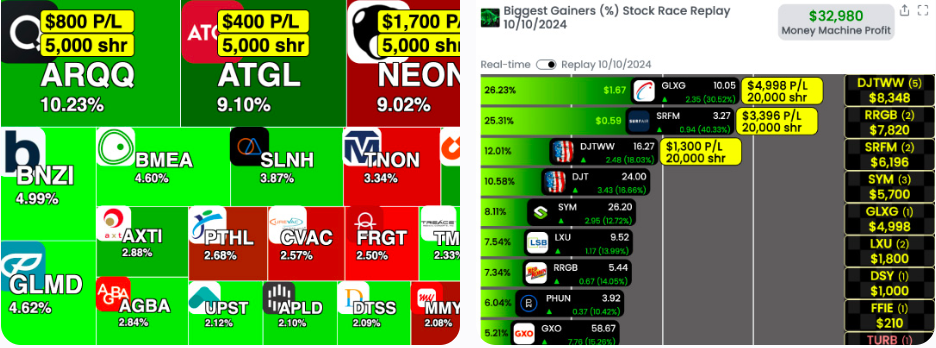20 Top Ideas For Selecting AI Stock Trading Platform Sites
20 Top Ideas For Selecting AI Stock Trading Platform Sites
Blog Article
Top 10 Tips To Assess The Market Coverage For Ai Stock Predicting/Analyzing Trading Platforms
Market coverage is one of the most important factors to take into consideration when looking at AI-powered trading platforms. This determines how many market and asset types can be accessed. A platform that has extensive market coverage lets you diversify your portfolio, discover global opportunities, and adapt to various trading strategies. These are the top 10 strategies for evaluating the market coverage provided by these platforms.
1. Evaluate Supported Asset Classes
Stocks - Make sure the platform can cover the major markets for stocks (e.g. NYSE NASDAQ LSE HKEX), and also includes mid-caps, small-caps, and large-caps.
ETFs: Make sure that the ETF platform you are using offers an array of ETFs to give you a variety of exposure to different categories, themes, and regions.
Options and futures. Make sure that the platform is compatible with derivatives such options, futures, and leveraged instruments.
Commodities and Forex. Find out whether there are any forex pairings available, along with precious metals, energy commodities and other agricultural commodities.
Cryptocurrencies. Check if it supports all major cryptocurrencies and altcoins (e.g. Bitcoin, Ethereum).
2. Make sure that your area is covered
Global markets: The platform should be able to cover the major global markets, including North America and Europe, Asia-Pacific and emerging markets.
Make sure you focus on regional markets. Find out if a platform focuses on particular markets or regions that are aligned with your goals in trading.
Local exchanges. Find out if the platform supports exchanges local or regional to your location.
3. Consider comparing real-time data with delayed data Delayed Data
Real-time data - Ensure that the platform provides live market data that can assist you in making timely choices, especially for active traders.
Data that is delayed: Find out if delayed data is available for free or at a cheaper cost, which could be sufficient for long-term investors.
Data latency: See if the platform minimizes latency for data, particularly in high-frequency trading.
4. Analyze historical data availability
Depth of historical data If the platform is available, ensure that it has extensive historical data (e.g., 10+ years) to backtest and analyze.
Granularity: Verify if the historical data includes the intraday granularity aswell with weekly, daily and monthly.
Corporate actions: Confirm that the historical data taken into account stock splits (if appropriate), dividends and other corporate actions.
5. Check for market depth and order information
Data Level 2: Ensure the platform offers Level 2 (order book depth) to allow for more price discovery.
Check to see if your platform is displaying real-time price spreads.
Volume data: Check if your platform has specific volume data for analyzing market activity and liquidity.
6. Review the coverage of Indices and Sectors
Major indices - Ensure your platform supports major indices, like the S&P 500 (e.g. NASDAQ 100 or FTSE 100), for benchmarking using indexes.
Data for specific industries: If you want to conduct a more specific analysis, check if there is data available for certain sectors.
Custom indices: Verify whether the platform supports the creation or tracking of custom indices that meet your requirements.
7. Integrate News and Sentiment Data
News feeds: Ensure the platform is able to integrate live news feeds of reputable sources (e.g., Bloomberg, Reuters) for market-moving events.
Sentiment analysis: Determine if there are tools for sentiment analysis based off of social media posts, news articles or other data sources.
Event-driven Strategies: Verify whether the platform supports strategies that are driven by events (e.g. economic reports, earnings announcements).
8. Verify Multimarket Trading Capabilities
Cross-market trade: Make sure the platform supports trading across markets and asset categories from a common interface.
Currency conversion: Check whether the platform allows multi-currency trading and automated conversion of currencies to facilitate international trade.
Time zone support: Determine whether the trading platform you are using is compatible with various time zones to trade on global markets.
9. Assess Coverage of Alternative Data Sources
Alternative data - Look to see if there are alternative data sources integrated into the platform (e.g. web traffic, satellite imagery or credit card transactions). This will give you unique insights.
ESG Data Look to determine whether there is any environmental, social, or governance (ESG data) included in the platform for socially responsible investing.
Macroeconomic data: Make sure that the platform has macroeconomic data (e.g. inflation, GDP) for fundamental analysis.
Examine the Feedback of Users and Market Reputation
User reviews: Search for user reviews to gain a better understanding of the platform.
Industry reputation: See whether the platform has been praised as a market leader by industry experts or awards.
Case studies: Search for case studies or testimonials which highlight the platform's performance in specific assets or markets.
Bonus Tips
Trial period for free: Try the coverage in the marketplace of the platform as well as the quality of its data with either a trial or demo.
API access: Determine if your platform's API allows access to market data in a programmatic manner to conduct custom analysis.
Customer support. Make sure that the platform provides assistance with regard to market or data questions.
Use these guidelines to assess the market coverage provided by AI stock trading platforms. Select a platform that has access to the market, data and tools that you need to make trading successful. Comprehensive market coverage enables you to diversify your portfolio, look for new opportunities, and adapt to market conditions that change. Take a look at the most popular breaking news for ai stock trading for website recommendations including trading with ai, incite, ai investing, ai for trading, ai for stock trading, ai stock trading app, best ai trading software, trading ai, ai for stock predictions, using ai to trade stocks and more.
Top 10 Tips For Evaluating The Regulatory Compliance Of Ai Stock-Predicting/Analyzing Trading Platforms
Regulation compliance is an important aspect to consider when evaluating trading platforms that use AI. Compliance ensures that the platform works within legal frameworks, protects the privacy of users, and conforms to financial regulations, thus reducing the possibility of legal problems or financial penalties. Here are the top 10 ways to evaluate the regulatory compliance of these platforms:
1. Verify Registration and Licensing
Regulatory bodies: Make sure the platform is certified and registered with appropriate financial regulatory bodies (e.g. SEC in U.S.A., FCA UK, ASIC Australia).
Verify the broker relationship: If your platform integrates with brokers and brokers, you need to make sure that these brokers are also licensed and regulated.
Public records: You can look on the official website of the regulatory body to determine whether the platform is registered and if there has been any violations in the past.
2. Assessment of Data Privacy Compliance
GDPR: If operating in or serving users in the EU, ensure the platform meets the requirements of the General Data Protection Regulation (GDPR).
CCPA -- California Consumer Privacy Act: Verify compliance of California users.
Data handling policy: Ensure that you go through the platform's privacy policies to learn the ways in which data of users is collected and stored.
3. Assess Anti-Money-Laundering (AML) measures
AML policies: Make sure the platform has robust AML policies to detect and prevent cash laundering.
KYC procedures - Ensure that the platform complies with Know Your Customer procedures for verifying user identities.
Monitor transactions: Check if the platform can monitor transactions and reporting any suspicious activities to the relevant authorities.
4. Make sure you are in compliance with Trading Regulations
Market manipulation: Ensure that your platform has safeguards in place to prevent any market manipulation, such as the spoofing of trading and wash trading.
Order types: Confirm that the platform meets regulations regarding order types (e.g. No unlawful stop-loss hunting).
Best execution: Make sure that the platform adheres to the most efficient execution procedures to ensure that trades are executed at the highest price.
5. Cybersecurity Assessment
Data encryption: Ensure the platform has encryption in place to protect user data in transit and in rest.
Response to incidents. Verify that there is clearly identified incident response plan on the platform for cyberattacks and data breaches.
Certifications - See whether your platform is certified. cybersecurity certifications.
6. Transparency & Disclosure:
Disclosure of fees - Make sure the fees are fully revealed, including additional or hidden charges.
Risk disclosure - Make sure that the platform provides clear risk disclosures. This is crucial when trading strategies have high leverage or risks.
Performance reporting: Ensure the AI platform is transparent and provides precise performance data to its AI model.
7. Check for the conformity to International Regulations
Trans-border trade. If you intend to conduct international trade, make sure that your platform complies with all regulations applicable to it.
Tax reporting - Find out the platform's tools and reports that help users to comply with tax laws.
Sanctions compliance: Ensure the platform complies with international sanctions and doesn't allow trading with prohibited entities or countries.
8. Assess Record-Keeping & Audit Trails
Transaction records: To meet regulatory and auditing purposes, ensure that the platform has full logs of each transaction.
Logs of user activities Make sure your platform keeps track of all activities of users, like transactions, logins, as well as adjustments to settings for accounts.
Audit readiness: Determine if your platform can provide the necessary logs and documentation in the case of an inspection from a regulatory authority.
9. Examine compliance with AI Specific Regulations
Algorithmic Trading Rules If your platform allows trading using algorithms, ensure that it is compliant with the regulations like MiFID II (in Europe) or Reg SCI (in the U.S.).
Fairness and bias: Check whether the platform monitors and corrects biases within its AI models to ensure ethical and fair trading.
Explainability - Make sure that the system is able to clearly and concisely explain regarding AI-driven predictions, decision-making, etc. in accordance with certain regulations.
10. Review User Comments and Regulatory Historical The History
Feedback from users: Read reviews from users to determine the credibility of the platform in terms of regulatory conformity.
The history of regulatory compliance: Find out whether the platform has a past history of violations by the regulatory authorities such as fines, penalties, or sanctions.
Third-party inspections: Verify whether the platform is subject to regular third-party inspections in order to ensure that the platform is in compliance.
Bonus Tips
Legal consultation: Think about consulting an expert in the field of law to examine the platform's conformity to relevant rules.
Free trial period: You may use a demo or free trial to try out the compliance features of the platform as well as its documentation.
Customer Support: Make sure that the platform has customer support for any questions or issues related to compliance.
By following these tips, you can effectively assess the compliance with regulations of AI platforms for analyzing and predicting stocks making sure you select one that adheres to legal frameworks and protects your rights. The compliance reduces legal risk and increases trust in the platform. Check out the recommended trading ai tool for more recommendations including best ai penny stocks, trading ai tool, ai tools for trading, best ai penny stocks, ai investment tools, how to use ai for stock trading, stock predictor, best ai stocks, ai investment tools, ai options and more.